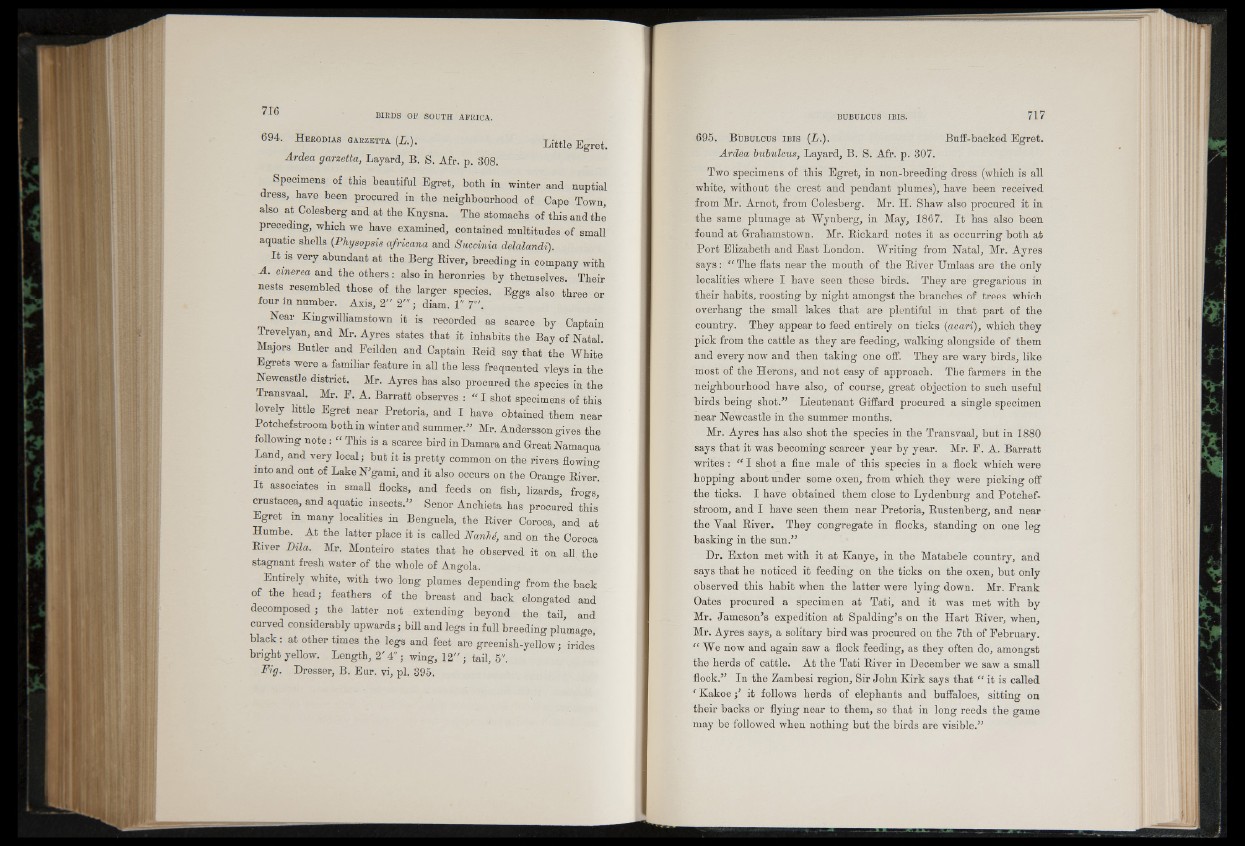
694. H erodias garzetta (£.). Little Egret.
Ardea garzetta, Layard, B. S. Afr. p. 308.
Specimens of this beautiful Egret, both in winter and nuptial
dress, have been procured in the neighbourhood of Cape Town,
also at Colesberg and at the Knysna. The stomachs of this and the
preceding, which we have examined, contained multitudes of small
aquatic shells {Physopsis africana and Succinia delalandi).
I t is very abundant at the Berg Biver, breeding in company with
A. cinerea and the others: also in heronries by themselves. Their
nests resembled those of the larger species. Eggs also three or
four in number. Axis, 2" 2"' ; diam. 1" 7".
Near Kingwilliamstown it is recorded as scarce by Captain
Trevelyan, and Mr. Ayres states that it inhabits the Bay of Natal.
Majors Butler and Feilden and Captain Reid say that the White
Egrets were a familiar feature in all the less frequented vleys in the
Newcastle district. Mr. Ayres has also procured the species in the
Transvaal. Mr. P. A. Barratt observes : “ I shot specimens of this
lovely little Egret near Pretoria, and I have obtained them near
Potchefstroom bothm winter and summer.” Mr. Andersson gives the
following note : “ This is a scarce bird in Damara and Great Namaqua
Land, and very local; but it is pretty common on the rivers flowing
into and out of LakeN’gami, and it also occurs on the Orange River.
It associates in small flocks, and feeds on fish, lizards, frogs,
Crustacea, and aquatic insects.” Senor Anchieta has procured this
Egret in many localities in Benguela, the River Coroca, and at
Humbe. At the latter place it is called NanhS, and on the Coroca
River Dila. Mr. Monteiro states that he observed it on all the
stagnant fresh water of the whole of Angola.
Entirely white, with two loDg plumes depending from the back
of the head; feathers of the breast and back elongated and
decomposed; the latter not extending beyond the tail, and
curved considerably upwards; bill and legs in full breeding plumage,
black: at other times the legs and feet are greenish-yellow; irides*
bright yellow. Length, 2' 4"; wing, 12” ; tail, 5".
Fig. Dresser, B. Eur. vi, pi. 395.
695. B ubulcus ib is (£.). Buff-backed Egret.
Ardea bubulcus, Layard, B. S. Afr. p. 307.
Two specimens of this Egret, in non-breeding dress (which is all
white, without the crest and pendant plumes), have been received
from Mr. Arnot, from Colesberg. Mr. H. Shaw also procured it in
the same plumage at Wynberg, in May, 1867. It has also been
found at Grahamstown. Mr. Rickard notes it as occurring both at
Port Elizabeth and East London. Writing from Natal, Mr. Ayres
says: “ The flats near the mouth of the River Umlaas are the only
localities where I have seen these birds. They are gregarious in
their habits, roosting by night amongst the branches of trees which
overhang the small lakes that are plentiful in that part of the
country. They appear to feed entirely on ticks (acari), which they
pick from the cattle as they are feeding, walking alongside of them
and every now and then taking one off. They are wary birds, like
most of the Herons, and not easy of approach. The farmers in the
neighbourhood have also, of course, great objection to such useful
birds being shot.” Lieutenant Giffard procured a single specimen
near Newcastle in the summer months.
Mr. Ayres has also shot the species in the Transvaal, but in 1880
says that it was becoming scarcer year by year. Mr. F. A. Barratt
writes : “ I shot a fine male of this species in a flock which were
hopping about under some oxen, from which they were picking off
the ticks. I have obtained them close to Lydenburg and Potchefstroom,
and I have seen them near Pretoria, Rustenberg, and near
the Yaal River. They congregate in flocks, standing on one leg
basking in the sun.”
Dr. Exton met with it at Kanye, in the Matabele country, and
says that he noticed it feeding on the ticks on the oxen, but only
observed this habit when the latter were lying down. Mr. Frank
Oates procured a specimen at Tati, and it was met with by
Mr. Jameson’s expedition at Spalding’s on the Hart River, when,
Mr. Ayres says, a solitary bird was procured on the 7th of February.
“ We now and again saw a flock feeding, as they often do, amongst
the herds of cattle. At the Tati River in December we saw a small
flock.” In the Zambesi region, Sir John Kirk says that “ it is called
‘ Kakoe;’ it follows herds of elephants and buffaloes, sitting on
their backs or flying near to them, so that in long reeds the game
may be followed when nothing but the birds are visible.”